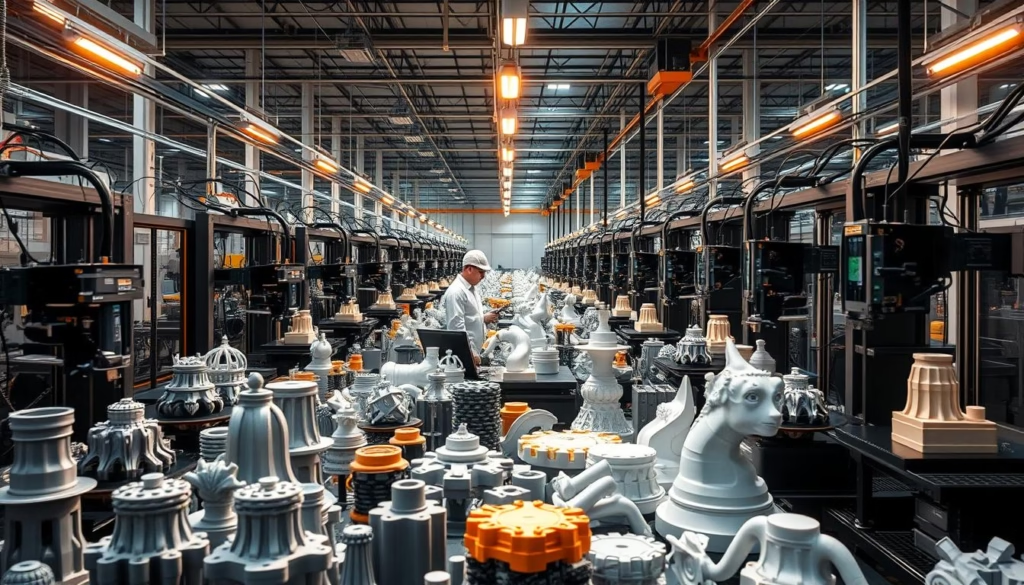You’re on the verge of exploring a technology that’s changing how we make things. Additive manufacturing is making waves in many fields. It lets us create complex designs that were once out of reach.
This tech lets you make prototypes, parts ready for production, and custom items easily. The range of what you can do is huge. It’s opening up new ways to design, make, and innovate.
Key Takeaways
- You can create complex designs with additive manufacturing.
- Rapid prototyping is one of the key benefits of this technology.
- Custom products can be produced with ease.
- The technology is revolutionizing industries and empowering individuals.
- New possibilities in design, manufacturing, and innovation are emerging.
Understanding 3D Printing Technology
Exploring 3D printing means learning about its core technology. It turns digital designs into real objects. This tech has changed making things, making rapid prototyping and production faster and more precise.
The Basics of 3D Printing
3D printing is all about adding material, not taking it away. It starts with a digital design. This design is broken down into thin layers by software.
The 3D printer then builds the object layer by layer. It uses the design to know where to put the material.
Different 3D Printing Methods
There are many 3D printing ways, each good for different things. Here are a few:
- Fused Deposition Modeling (FDM) uses melted plastic to build objects.
- Stereolithography (SLA) uses a laser to harden liquid resin into solid objects.
- Selective Laser Sintering (SLS) fuses powdered material with a laser.
Each method has its own strengths and is best for certain projects.
Essential Materials for 3D Printing
3D printing uses many materials, like plastics, metals, ceramics, and glass. The right material depends on the printing tech and what you need the object to be like. For example, FDM often uses ABS or PLA plastics.
SLS can work with many powdered materials, including metals and ceramics. Knowing about these materials helps pick the best one for your project. This way, you can get the most out of 3D printer technology.
Applications of 3D Printing in Various Industries
3D printing can make complex shapes, changing how we design and make things. It’s not just making things better; it’s changing how we do it.
Many industries are using printing because it’s so versatile. It lets us make prototypes fast, customize products, and create parts that are hard to make otherwise.
3D Printing in Healthcare
In healthcare, printing makes custom implants, prosthetics, and surgical models. This helps patients get better faster and makes implants fit better. It’s a big step forward.
It’s also starting to make organs for transplants. This is still new, but it could save many lives and improve health greatly.

Use in Automotive Manufacturing
The car industry uses 3D printing for quick prototypes and parts. It makes parts that are hard to make otherwise, making cars safer and better.
It also lets people make custom car parts and accessories. This means cars can be truly unique, from dashboards to engine parts.
| Industry | Application | Benefits |
|---|---|---|
| Healthcare | Custom implants, prosthetics, surgical models | Improved patient outcomes, reduced recovery times |
| Automotive | Rapid prototyping, complex parts production | Enhanced vehicle performance, safety, and customization |
| Consumer Goods | Personalized products, custom jewelry, tailored furniture | Increased product customization, enhanced customer satisfaction |
Printing for Consumer Goods
For consumer goods, printing makes personalized products like jewelry and furniture. This was once impossible but is now possible for many.
It lets customers get what they want, when they want it. This makes them happier and helps companies not have to make as much stuff ahead of time.
Getting Started with 3D Printing
Now you know about printing technology and its uses. It’s time to start making three-dimensional objects. This section will help you begin, whether for personal projects or business needs.
Selecting the Appropriate 3D Printer
Choosing the right 3D printer is key. Think about your projects, space, and budget. Look at different models and their features like print quality and material compatibility.
Essential Software for 3D Printing
You’ll need design tools and slicer programs to get started. Learn about software like Tinkercad, Fusion 360, or Simplify3D. They help design and prepare models for printing.
Best Practices for 3D Printing Projects
For a successful project, plan carefully. Design with printing in mind and know how to fix common issues. If you’re not ready for your own printer, use printing services for top-notch results.